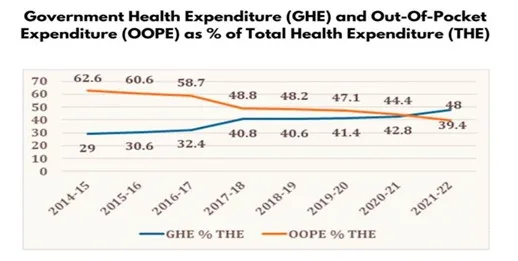Syllabus:GS2/ Health, GS2/ Governance
Context
- According to National Health Accounts estimates for 2021-22, India has recorded a decline in out-of-pocket expenditure (OOPE).
- The report suggests that the OOPE declined from 64.2% in 2013-14 to 39.4% in 2021-22.
Out-of-Pocket Expenditure (OOPE)
- Out-of-Pocket Expenditure (OOPE) in healthcare refers to the money people pay directly from their own pockets for medical services, such as doctor visits, medicines, and hospital stays.
- OOPE forces low-income families to spend a large portion of their earnings or savings on healthcare.
- This financial burden can push families into poverty, create debt, and make it harder for them to afford other essentials like food and education.

Reasons for the Decline in OOPE
- Government Health Expenditure (GHE): Between 2014-15 and 2021-22, the government’s share of health expenditure grew from 1.13% to 1.84% of GDP.
- Expansion of Social Security Expenditure (SSE): Government-funded health insurance and social health programs, rose from 5.7% of Total Health Expenditure (THE) in 2014-15 to 8.7% in 2021-22.
- Government-Funded Insurance Schemes: Programs like Ayushman Bharat, along with various state-level health insurance schemes, have provided insurance coverage to economically vulnerable populations.
- Targeted Programs for Non-Communicable Diseases (NCDs): With rising cases of NCDs, the government has initiated targeted programs to manage and prevent these long-term health conditions.
- Focus on Public Health Infrastructure and Workforce has increased in rural and underserved regions.
Government Schemes
- Ayushman Bharat Pradhan Mantri Jan Arogya Yojana (PMJAY): It provides health coverage of up to ₹5 lakh per family per year for secondary and tertiary care hospitalization.
- Pradhan Mantri Jan Aushadhi Yojana (PMJAY): It provides quality generic medicines available at affordable prices through Jan Aushadhi Kendras.
- Rashtriya Swasthya Bima Yojana (RSBY): It offers health insurance for below-poverty-line (BPL) families, with coverage up to ₹30,000 for most diseases requiring hospitalization.
- Telemedicine Services (eSanjeevani): Facilitates remote consultation services, which help in reducing the cost burden associated with traveling and in-person consultations.
- Pradhan Mantri Surakshit Matritva Abhiyan (PMSMA): It provides assured, comprehensive, and quality antenatal care, free of cost, on the 9th of every month.
Implications of Reduced OOPE for India’s Healthcare System
- Increased Financial Stability for Households: With less of their income going towards healthcare expenses, families can allocate funds toward other essentials, improving their financial resilience.
- Foundation for Universal Health Coverage: The decline in OOPE and strengthened public healthcare funding align with India’s long-term goal of achieving universal health coverage.
- Encouragement for Workforce Participation in Healthcare: With better government funding, healthcare facilities can hire and train more staff, which improves service delivery, especially in underserved areas.
Concluding remarks
- The reduction in OOPE is a transformative shift, marking India’s commitment to a more inclusive healthcare system.
- As the government continues to invest in healthcare, the future holds the potential for universal health coverage where everyone, irrespective of income, has access to quality medical services.
- This shift does not only signify financial relief but also enhances India’s public health resilience, promoting a healthier, more economically stable population.
Source: PIB
Previous article
Breaching of Antitrust Laws By Food Delivery Giants
Next article
Adaptation Gap Report 2024